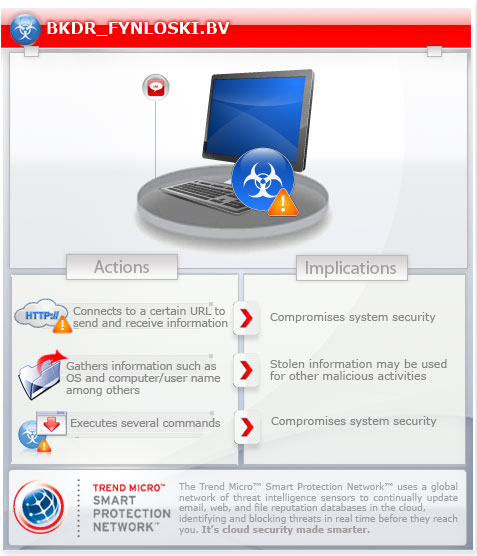BKDR_FYNLOSKI.BV
Backdoor:Win32/Fynloski.A (Microsoft)
Windows 2000, Windows XP, Windows Server 2003


Threat Type: Backdoor
Destructiveness: No
Encrypted: Yes
In the wild: Yes
OVERVIEW
Via instant message
This backdoor disguises as a revolutionary document in order to lure Syrian activists into downloading and executing the malware.
To get a one-glance comprehensive view of the behavior of this Backdoor, refer to the Threat Diagram shown below.

This backdoor gathers certain information on the affected system. It logs active windows and user key strokes. It is capable of executing several commands on the affected system.
This backdoor opens a hidden Internet Explorer window. It connects to a website to send and receive information.
TECHNICAL DETAILS
3,221,392 bytes
Other
Yes
04 Jun 2012
Connects to URLs/IPs, Steals information
Installation
This backdoor drops the following files:
- %User Temp%\explorer.exe - also detected as BKDR_FYNLOSKI.BV
- %User Temp%\Firefox.dll - encrypted component detected as BKDR_FYNLOS.ENC
- %User Temp%\Aleppo plan.pdf - non-malicious PDF file
(Note: %User Temp% is the current user's Temp folder, which is usually C:\Documents and Settings\{user name}\Local Settings\Temp on Windows 2000, XP, and Server 2003.)
It adds the following mutexes to ensure that only one of its copies runs at any one time:
- DC_MUTEX-F54S21D
Autostart Technique
This backdoor drops the following file(s) in the Windows User Startup folder to enable its automatic execution at every system startup:
- (empty).lnk
Other System Modifications
This backdoor adds the following registry keys:
HKEY_CURRENT_USER\Software\DC3_FEXEC
Backdoor Routine
This backdoor opens a hidden Internet Explorer window.
It connects to the following websites to send and receive information:
- {BLOCKED}.{BLOCKED}.0.28
Stolen Information
This backdoor saves the stolen information in the following file:
- %User Temp%\dclogs.sys
(Note: %User Temp% is the current user's Temp folder, which is usually C:\Documents and Settings\{user name}\Local Settings\Temp on Windows 2000, XP, and Server 2003.)
NOTES:
This backdoor arrives as a RAR archive that is sent over Skype by a malicious user.
It gathers the following information from the affected system:
- Administrative rights
- Computer/User name
- HWID
- Language/Country
- Operating System information
- RAM used
- Web cam information
It logs active windows and user key strokes.
It is capable of executing the following commands:
- Disable notifications of antivirus software
- Display a message box
- Download an updated copy of itself
- Download and execute files
- List active windows
- Manipulate files
- Manipulate processes
- Manipulate registries
- Modify privileges
- Modify the hosts file
- Modify user groups
- Monitor webcam activity
- Open command prompt
- Steal passwords
- Uninstall applications
- Uninstall itself
SOLUTION
9.200
9.173.00
05 Jun 2012
Step 1
For Windows XP and Windows Server 2003 users, before doing any scans, please make sure you disable System Restore to allow full scanning of your computer.
Step 2
Remove malware files dropped/downloaded by BKDR_FYNLOSKI.BV
- BKDR_FYNLOS.ENC
Step 3
Restart in Safe Mode
Step 4
Search and delete these files
- %User Temp%\Aleppo plan.pdf
- %User Temp%\dclogs.sys
- %User Startup%\(empty).lnk
Step 5
Delete this registry key
Important: Editing the Windows Registry incorrectly can lead to irreversible system malfunction. Please do this step only if you know how or you can ask assistance from your system administrator. Else, check this Microsoft article first before modifying your computer's registry.
- In HKEY_CURRENT_USER\Software
- DC3_FEXEC
- DC3_FEXEC
Step 6
Restart in normal mode and scan your computer with your Trend Micro product for files detected as BKDR_FYNLOSKI.BV. If the detected files have already been cleaned, deleted, or quarantined by your Trend Micro product, no further step is required. You may opt to simply delete the quarantined files. Please check this Knowledge Base page for more information.
Did this description help? Tell us how we did.

